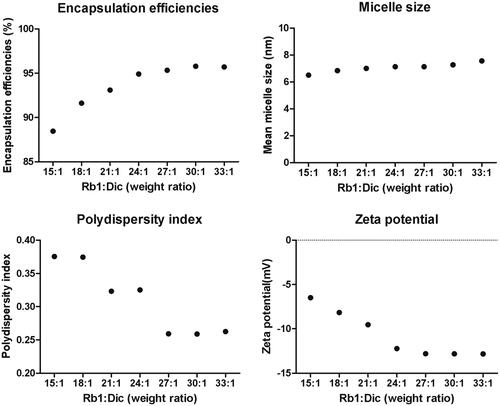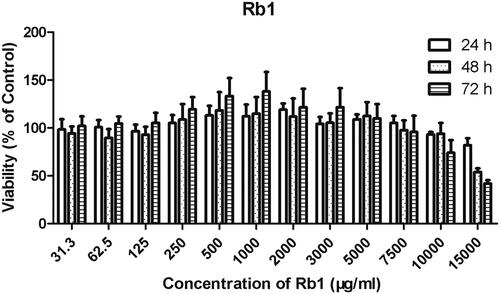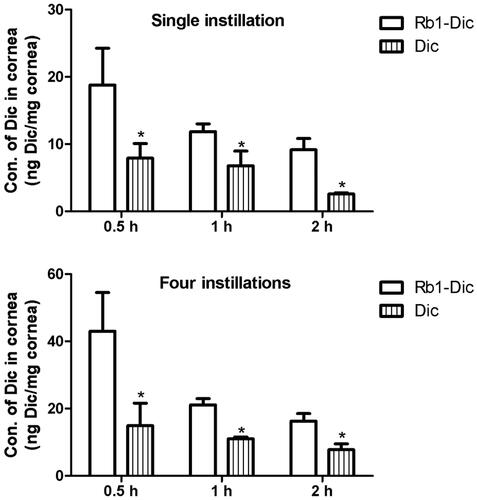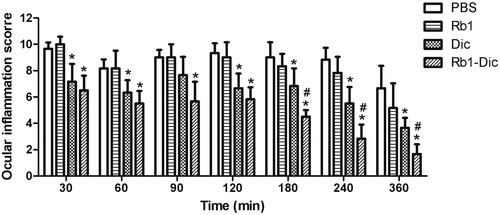Figures & data
Figure 1. Changes in Rb1 micelle characteristics. Encapsulation efficiencies, micelle size, polydispersity index, and zeta potential were tested as functions of different weight ratios of Rb1 to diclofenac.

Figure 2. Characterization of the Rb1-Dic micelle solution. (A) TEM morphology of Rb1-Dic micelles (×400k magnification, bar = 50 nm) and the appearance of the Rb1-Dic micelle solution; (B) Storage stability at 25 °C and protected from light; (C) Particle size distribution; and (D) Zeta potential characterization of the Rb1-Dic micelle ophthalmic solution (Rb1/diclofenac weight ratio of 30:1).

Figure 3. Cytotoxicity evaluation of Rb1 (n = 3). The cytotoxicity of Rb1 and the Rb1-Dic micelle was tested on Human corneal epithelial cells (HCECs; ATCC CRL-11135) using standard MTT testing. HCECs were incubated with the indicated concentrations of ginsenoside Rb1 for 24, 48, and 72 h, followed by 4 hours incubation with MTT. The MTT transformed crystals were dissolved in DMSO and absorbance at 490 nm was measured. Absorbances were normalized to the untreated control cultures, which represented 100% viability.

Figure 4. Cytotoxicity evaluation of diclofenac-loaded ginsenoside Rb1 (Rb1-Dic) micelles (n = 3). An MTT assay was performed on Human ATCC CRL-11135 corneal epithelial cells (HCECs). HCECs were incubated with Rb1-Dic micelles for (A) 24 h, (B) 48 h, and (C) 72 h; (D) HCECs incubated for 1 h with Rb1-Dic micelle formulations, commercial diclofenac (Dic) eye drops, and benzalkonium chloride (BAC) as a positive control. MTT transformed crystals were dissolved in DMSO and absorbance at 490 nm was measured. Absorbances were normalized to the untreated control cultures, which represented 100% viability. (*p < .05 when compared to the Rb1-Dic micelle group).

Figure 5. In vivo corneal permeation of diclofenac from diclofenac-loaded ginsenoside Rb1 (Rb1-Dic) micelles. (A) Diclofenac concentration in rabbit corneas after a single instillation (50 μl) of either an ophthalmologic preparation of diclofenac-loaded ginsenoside Rb1 (Rb1-Dic) micelles or commercial diclofenac eye drops (*p < .05 compared to the Rb1-Dic micelle ophthalmic solution, n = 6). (B) Diclofenac concentration in rabbit corneas after four instillations (50 μl/instillation at 10 min intervals) (*p < .05 compared to the Rb1-Dic micelle ophthalmic solution group, n = 6).

Figure 6. Anti-inflammatory efficacy of diclofenac-loaded ginsenoside Rb1 (Rb1-Dic) micelles. Anti-inflammatory efficacy of an ophthalmologic preparation of diclofenac-loaded ginsenoside Rb1 (Rb1-Dic) micelles, commercial diclofenac eye drops, and Rb1 solution after sodium arachidonate solution (SAS)-induced inflammation in rabbit eyes (Mean ± SD, n = 6, *p < .05 compared to the PBS control group, #p < .05 compared to the commercial diclofenac eye drop group).

